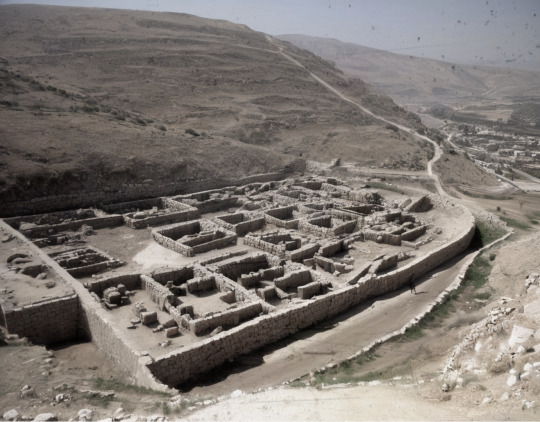The Encyclopedia of History, Culture and Religion of the City of Yish'ael
Don't wanna be here? Send us removal request.
Text
Religion in Ishael
"The faith born from divine questions, not answers."
Origins and Theological Foundations
The Ishaelic religion emerged in the 9th century BCE in the city of Ishael, located in west of Samaria. Rooted in the teachings of Ishael, the son of Esau and Mahalath, it centered on the belief that "questioning God" was the highest form of piety. Key tenets include:
The Twenty Sacred Questions: A set of existential and ethical inquiries believed to have been divinely revealed to Ishael. Examples: "Why does silence reign when the righteous cry out?"; "Can a mortal’s defiance rewrite divine decree?"
Progressive Revelation: The idea that divine truth unfolds through a lineage of Twenty Prophets, categorized as Mythical, Ancient, and Recent.
The Ashalah Tree: A sacred white acacia symbolizing the link between humanity’s doubts and divine wisdom. Its leaves were used in rituals to "invoke clarity."
Sacred Texts
1. The Scroll of Inquiry (Megillat ha-Sh’elot)
The oldest surviving text, written in a hybrid of Paleo-Hebrew and Aramaic, contains:
The original 20 Questions attributed to Ishael.
Prophetic commentaries, including Job’s meditation on suffering and Miriam’s ode to liberation.
A liturgical calendar tied to celestial events (e.g., rituals during the Pleiades’ zenith).
2. The Codex of the Twenty Prophets
Compiled in the 7th century BCE, this text blends history and theology:
Mythical Prophets: Treated as archetypes (e.g., Joseph as the "Interpreter of Dreams").
Recent Prophets: Controversially includes figures like Denial (Daniel), whose apocalyptic visions predate his historical existence.
Religious Practices
The Rite of Unanswered Questions: Pilgrims traveled to the Altar of Questions in Tel Ishael, where they inscribed their doubts on clay tablets and left them in the altar’s 20 niches.
The Festival of Whispers: Held at the autumn equinox, participants whispered the Sacred Questions into the wind, believing they would reach God’s ear.
The Scepter of Ashalah: A branch from the sacred tree carried by priests during disputes, symbolizing that "even justice must be questioned."
Hierarchy and Leadership
The Ishaelic priesthood was divided into three orders, mirroring the prophetic categories: Order Role Attire Mythkeepers Guardians of oral traditions Robes dyed with pomegranate Lawseekers Interpreters of sacred texts Bronze headbands inscribed with questions Visionaries Prophets-in-training Feathers from migratory birds (symbolizing foresight)
Archaeological Insights
Excavations at Tel Ishael (1960s–present) revealed:
The Question Altar: A limestone structure with 20 chambers, each holding fragments of tablets bearing variations of the Sacred Questions.
Ishael’s Tomb: A burial site containing a skeleton surrounded by 20 stone tablets. Inscriptions read: "Here lies the Questioner, whose voice echoes in heaven."
A Forgotten Library: Clay tablets referencing trade with Phoenicia and Egypt, including a treaty demanding "the right to doubt foreign gods."
Scholarly Disputes
Was Ishael a Dissident Priest?
Some argue he was a Canaanite priest who rejected Baal worship, repurposing local myths into monotheistic inquiry.
The “Recent” Anachronism:
References to Ezekiel (Jesuel) and Esther (Star) suggest the Codex was edited during the Babylonian exile to legitimize the tradition.
#IshaelicReligion#AncientMysteries#DivineQuestions#ProphetsOfDoubt#TelIshaelFinds#AshalahTree#QuestionEverything#ReligiousRebellion#ArchaeologyLovers#AcademicTumblr
1 note
·
View note
Text
The Twenty Prophets
The Twenty Prophets refers to a list of figures considered prophets in the ishaelic tradition. The list was developed between 795 BC and 765 BC, dividing the figures into "mythical": characters from the books of Genesis and Exodus, "ancient": historical figures widely known at that time, and finally, the "recent": prophets who, according to belief were yet to come.
Mythical
Hagar
Ishmael
Ishael
Joseph
Job
Bithiah
Miriam
Ancient
Zeborah (Zibora): probably Deborah
Shamuel (Shm'ale): probably Samuel
Shemaija (Shm'ya): probably Shemaiah
Julda (Yuh'lida): probably Hulda
Elijahi (Ale-I'yah): probably Elijah
Johnah (Yoh'na): probably Jonah
Recent
Jesus (Yeh'sh'ya): interpreted as Isaiah
Jeremy (Yeh'rm'ya): interd. as Jeremiah
Abacus (Abba'qquq): inted. as Habakkuk
Jesuel (Yeh'zq'ale): interprd. as Ezekiel
Star (Astar): interpreted as Esther
Denial (Dan-I'ale): interpreted as Daniel
Hanna (H'anna): uncertain
These last seven are the subject of debate among researchers, some of which may be a case of vaticinium ex eventu, others may not be possible, as they are generally interpreted as being historical figures who had not yet been born when the list was developed.
#ProphecyDebate#DanielInProphecy#VaticiniumExEventu#EstherAsAStar#MythicalProphets#AncientProphets#EzekielReimagined#RecentProphets
1 note
·
View note
Text
Ish'ale
Ishael (Ishaelic dialect: Ish'ale, pronounced as Išael, Hebrew: יִשָׁאֵל, romanized: Yīšāʿēʾl, lit. "God asks"; Arabic: Issāʿīl; Latin: Isael) was the son of Mahalath and Esau. Traditionally he is seen as the patriarch of the city of the same name.

The name "Yisha'el" existed in several ancient Semitic cultures, including ancient Babylon and Minæan. In the Amorite language it is attested as yaśaʿ-ʾel. It is a theophoric name literally translated as "God (El) asked", however, whose meaning is closer to "he who asks God".
In history, the prophet would have created a series of twenty questions to ask God, whose reflection on them revolutionized the theological understanding of those people.
The modern scholarly consensus is that the person of Ishael is largely mythical, while also holding that, most likely, a prominent political figure may have existed somewhere in Canaan in the pre-exilic period, who was named Yishael and was retro-projected in the biblical narrative as the son of Esau, later the city was renamed in his honor.
#MythologyMonday#DeepDive#FolkloreThursday#BiblicalMythology#HistoryBuff#AncientHistory#TheologyThoughts#AncientTheology#Edomites#ReligiousStudies#PreExilicPeriod#SemiticNames#AmoriteCulture#BiblicalGenealogy#QuestioningFaith#HebrewBible#MythVsHistory#ArchaeologyLovers#PropheticTraditions#GodAndHumanity#DivineInquiry#AcademicTumblr#AncientCities
3 notes
·
View notes
Text
Ishael
Yish'ael (Hebrew: יִשָׁאֵל, romanized: Yisha'el) or Ish'ael (Ishaelic dialect: Ish'ale, pronounced as Išael) was a city located west of Samaria, the city was destroyed by the Assyrians around 720 BC.

The name of the city refers to its mythical patriarch of the same name.
#AncientHistory#Archaeology#AssyrianEmpire#AncientCities#LostCities#AncientNearEast#AncientLanguages#Mythology#AncientWarfare#HistoryMysteries#HistoricalLinguistics#CulturalHeritage#HistoryLovers#TumblrHistory
2 notes
·
View notes



